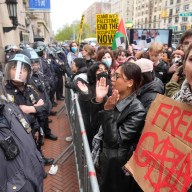 There are some Dr. Thackery-related bombshells on this episode of “The Knick.”
There are some Dr. Thackery-related bombshells on this episode of “The Knick.”
Credit: Mary Cybulski
There are a few major bombshells in the final 15 of “The Knick”’s sixth episode, but that doesn’t mean the 45-ish that preceded them were inferior. In fact, Steven Soderbergh’s old-timey hospital show is at its best when it’s just hanging out, recreating a bygone era. Even moreso than usual, this episode was a collection of great, isolated, one-off scenes — few terribly dramatic, which is to say ones that move plot(s) along, but terrific nonetheless.
To start with, those bombshells were appropriately jaw-dropping. First, brilliant but druggy physician Dr. Thackery (Clive Owen), with the help of the usually underutilized Dr. Chickering (Michael Angarano), cracked the Caesarian procedure that eluded them in the show’s first episode — the one whose failure led to the suicide of Thackery’s beardy mentor, Dr. Christiansen (Matt Frewer). This one’s a rousing success, and Thackery celebrates by accidentally stumbling upon Dr. Edward’s (Andre Holland) super-secret clinic.
A heated exchange follows, one which Thackery — who has been somewhere between casually racist and simply disinterested in racial progress — insists this isn’t about the color of Edwards’ skin but about lies and some questionable health issues. Things turn around when Thackery learns of some of Edwards’ experiments, including a machine that pumps blood, thus freeing up a doctor’s hand. What started as an ugly hairpin turn ended with Thackery belatedly coming to respect Edwards, agreeing to put his name on a hernia paper Edwards could never get published on his own and Edwards finally officially being welcomed into the Knickerbocker fold.
What came before is no less thrilling. What “The Knick” does best is hoover up its time, putting the past into the present. Soderbergh’s interests clearly don’t lie in the occasional melodramatic storylines. He’s about little details, technology that at the time seemed new, the line between the archaic and the futuristic, and science. Speaking of which, there’s another bombshell, and a very funny one: Smirking health inspector Jacob Spreight (David Fierro) finally located the source of the typhoid outbreak, which is to say the infamous Typhoid Mary — a lowly Irish cook who had been working at a variety of homes and institutions, unknowingly spreading her disease. The scene where they confront her, her strangely aggressive reaction and the messy tussle that follows is great comic fun — even if it’s a lie: The real Typhoid Mary was first quarantined in 1907, seven years after these events. But never let the truth get in the way of a fun scene.
 Dr. Chickering (Michael Angarano, opposite Eve Henson) finally gets…a bit of something to do.
Dr. Chickering (Michael Angarano, opposite Eve Henson) finally gets…a bit of something to do.
Credit: Mary Cybulski
The rest tends to little character moments, such as Chickering’s paean to working with the brilliant Thackery and watching him “invent the future.” There’s a thread about hospital director Barrow (Jeremy Bobb) buying a hand-me-down X-ray machine, then testing it out. It’s scenes like the one where Barrow has his head X-rayed (“This should take about an hour,” the merchant says) that “The Knick” feels like a more sprightly version of Mike Leigh’s period films, such as “Topsy-Turvy” and the forthcoming “Mr. Turner,” films that love to take big, fat digressions to observe people experiencing new technology. In fact, “Mr. Turner” has a lengthy scene where its protagonist gets his photograph taken that’s not unlike the business with the X-ray here — which then cuts to a scene in which Dr. Gallinger (Eric Johnson) and his wife have a picture taken of them with their newly deceased baby, so as to preserve the memory in material form.
Actually the best scene — as they often are on “The Knick” — is the one that starts the episode. Chickering gets a call from Thackery in the middle of the night, summoning him to the Knickerbocker not for an emergency but to help with an experiment. Chickering arrives to find a wired, drinking, sweaty, unkempt and excitable Thackery with two naked Chinatown prostitutes. They’re there as bodies on which to experiment with the Caesarian they will perfect later on. How are they supposed to experiment on non-pregnant prostitutes they don’t intend to maybe kill? Thackery kind of makes it make sense. (If you remember, in the previous episode Thackery mostly had it together.) It’s clear he was in a brothel when he happened upon this lightbulb-worthy idea, and not only didn’t mind cleaning himself up but got filthier.
Thackery’s obsession with, as Chickering put it, “inventing the future,” his raving passion, his eccentricity — these are things Soderbergh clearly identifies with. “The Knick” has been about finding the intersection that joins scientists with artists — that love for trying out the new, for pushing one’s self, for creating new avenues upon which others will casually trod. This is what Soderbergh has been doing as he tries out a medium with which he’s less familiar. (“K Street,” his previous show, was very unusual TV: partly improvised and scripted as it went along.) He’s (presumably, I guess) nowhere near as self-destructive as Thackery, but the fire in Thackery’s eyes when he’s truly inspired is the same you can imagine in Soderbergh’s eyes when “The Knick” is really cooking. And this is an episode that really cooks — even if, as us journalists covering “The Knick” already know, the next one is even better.
Grade: A-
Obligatory stray observations:
— It’s a really good joke that the man who peddles X-ray machines is also someone who peddles elixirs. He has feet in both worlds: the technological/real and the swindling. The scene where he pitches Thackery on putting his face and name on a potion is another of this episode’s terrific scenes.
— On the other hand, one thing “The Knick” doesn’t always do well is dialogue. The subplot about Thackery tending to an old flame whose nose was partially eaten away by syphilis is great — save the clunkers the actors must recite. She to him when he says it looks like rain: “It always looks like rain if you look at the clouds. Don’t look at the cloud so much, John.” Bleccccccccccccch.
— That final scene is very unnerving — and beautifully played and shot. Soderbergh likes to shoot some scenes in long takes that focus on something small, like one actor, such as the scene that stares at a mostly unspeaking Gallinger as he and his wife deal with their dying baby. But this classic shot-reverse shot exchange between Constance (Juliet Rylance) and her suddenly lecherous-ish future father-in-law is unhurried and all the more effective for how long it holds on each person.
Read previous “The Knick” recaps:Episode 1,Episode 2,Episode 3,Episode 4and Episode 5.
Follow Matt Prigge on Twitter @mattprigge
















